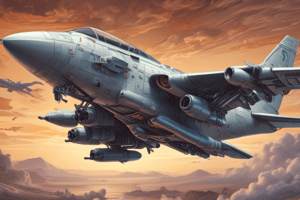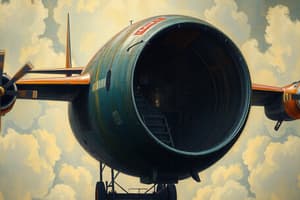Podcast
Questions and Answers
Which type of fuselage construction primarily relies on the strength of the skin or covering to carry the primary loads?
Which type of fuselage construction primarily relies on the strength of the skin or covering to carry the primary loads?
- Semimonocoque
- Monocoque (correct)
- Reinforced shell
- Truss-type
What structural elements are used in true monocoque construction to shape the fuselage?
What structural elements are used in true monocoque construction to shape the fuselage?
- Formers, frame assemblies, and bulkheads (correct)
- Diagonal bracing and vertical web members
- Longerons and stringers
- Truss-type elements
What is the main challenge in monocoque construction?
What is the main challenge in monocoque construction?
- Maintaining enough strength while keeping weight within limits (correct)
- Creating a Warren truss structure
- Using longerons and stringers for primary load-bearing
- Adding more bracing members for extra support
Which structural members are located at intervals in monocoque construction to carry concentrated loads?
Which structural members are located at intervals in monocoque construction to carry concentrated loads?
What are the primary functions of stringers in a monocoque fuselage?
What are the primary functions of stringers in a monocoque fuselage?
What prevents tension and compression from bending the fuselage in monocoque construction?
What prevents tension and compression from bending the fuselage in monocoque construction?
What is the main difference between stress and strain?
What is the main difference between stress and strain?
What type of stress resists a force that tends to pull something apart?
What type of stress resists a force that tends to pull something apart?
How is the tensile strength of a material measured?
How is the tensile strength of a material measured?
What does compression stress resist?
What does compression stress resist?
Which stress tends to shorten or squeeze aircraft parts?
Which stress tends to shorten or squeeze aircraft parts?
What does torsion stress produce?
What does torsion stress produce?
Who published a definitive work called 'Progress in Flying Machines'?
Who published a definitive work called 'Progress in Flying Machines'?
What was the major contribution of Octave Chanute to aircraft structure development?
What was the major contribution of Octave Chanute to aircraft structure development?
When did the Wright Brothers build their successful powered airplane?
When did the Wright Brothers build their successful powered airplane?
What material were the wings of the Wright Flyer primarily made of?
What material were the wings of the Wright Flyer primarily made of?
Who is referred to as the 'father of aeronautics' in the text?
Who is referred to as the 'father of aeronautics' in the text?
How did powered heavier-than-air aviation grow according to the text?
How did powered heavier-than-air aviation grow according to the text?
What are the additional support pieces between longerons and stringers in aircraft construction often referred to as?
What are the additional support pieces between longerons and stringers in aircraft construction often referred to as?
How are manufacturers nomenclature for structural members like rings, frames, and formers described in the text?
How are manufacturers nomenclature for structural members like rings, frames, and formers described in the text?
What modification to monocoque construction was developed to overcome the strength/weight problem in aircraft design?
What modification to monocoque construction was developed to overcome the strength/weight problem in aircraft design?
In semimonocoque construction, what reinforces the skin of the aircraft in addition to frame assemblies, bulkheads, and formers?
In semimonocoque construction, what reinforces the skin of the aircraft in addition to frame assemblies, bulkheads, and formers?
What are the longitudinal members that supplement longerons in aircraft construction referred to as?
What are the longitudinal members that supplement longerons in aircraft construction referred to as?
What materials are commonly used in constructing semimonocoque fuselages according to the text?
What materials are commonly used in constructing semimonocoque fuselages according to the text?
What holds the bulkheads and formers in semimonocoque fuselages?
What holds the bulkheads and formers in semimonocoque fuselages?
Which component is described as a type of connection bracket that adds strength?
Which component is described as a type of connection bracket that adds strength?
Why can a semimonocoque fuselage withstand considerable damage and still be strong enough to hold together?
Why can a semimonocoque fuselage withstand considerable damage and still be strong enough to hold together?
What are some components used to achieve a strong, rigid framework in aircraft construction?
What are some components used to achieve a strong, rigid framework in aircraft construction?
In semimonocoque fuselages, what do frames facilitate the design and construction of?
In semimonocoque fuselages, what do frames facilitate the design and construction of?
What is responsible for carrying part of the load in a semimonocoque fuselage?
What is responsible for carrying part of the load in a semimonocoque fuselage?
Flashcards are hidden until you start studying
Study Notes
Fuselage Construction Types
- Monocoque Construction: Primarily relies on the skin to bear the primary loads of the fuselage.
- True Monocoque Structural Elements: Uses skin alone with no internal framework to maintain shape.
- Main Challenge in Monocoque Construction: Achieving adequate strength while minimizing weight for efficiency.
Structural Members and Functions
- Members for Load Support: Bulkheads and formers are spaced at intervals to support concentrated loads.
- Role of Stringers: Provide additional support, prevent buckling, and distribute loads evenly along the fuselage.
- Prevention of Bending: The skin's rigidity prevents tension and compression from causing bending.
Stress and Strength Concepts
- Difference Between Stress and Strain: Stress is the force applied per unit area, while strain is the deformation resulting from that stress.
- Tensile Stress: Resists forces that attempt to pull materials apart.
- Measuring Tensile Strength: Assessed through tensile testing, determining maximum stress a material can withstand while being stretched.
- Compression Stress: Resists forces that attempt to compress or shorten materials.
- Effects of Torsion Stress: Produces twisting forces that can lead to material failure if excessive.
Historical Contributions
- Octave Chanute's Publication: Authored 'Progress in Flying Machines,' which compiled knowledge and advances in aviation.
- Wright Brothers' Milestone: Successfully built and flew their powered airplane in 1903.
- Material of the Wright Flyer Wings: Primarily constructed from wood, which provided necessary strength and weight characteristics.
- Father of Aeronautics: Referred to Octave Chanute for his significant contributions to aircraft development.
Aircraft Construction Techniques
- Support Pieces in Construction: Additional elements between longerons and stringers are often called 'ribs' or 'intercostals.'
- Manufacturer Nomenclature: Structural members such as rings, frames, and formers are critical for defining the aircraft's structural integrity.
- Modification of Monocoque Construction: Semimonocoque construction improves strength-to-weight ratio through the use of reinforcements.
Semimonocoque Features
- Reinforcement in Semimonocoque: Utilizes frame assemblies, bulkheads, formers, and a reinforced skin to support loads.
- Supplementary Longitudinal Members: Referred to as 'stringers,' they enhance strength and structural stability of the fuselage.
- Common Materials Used: Typically includes aluminum alloys, composite materials, and steel for durability and weight management.
- Holding Components in Semimonocoque: The bulkheads and formers are secured by rivets or bonding techniques to maintain structural integrity.
- Connection Bracket Function: A type of connecting bracket adds strength to fuselage joint areas and load transfer.
Structural Resilience and Framework
- Strength After Damage: Semimonocoque fuselages maintain structural integrity even after sustaining significant damage, due to their design and reinforcement.
- Components for Strong Framework: Features ribs, longerons, and cross-bracing to create a sturdy skeleton for the fuselage.
- Frames' Role: Facilitate design and construction, ensuring correct alignments and load distribution within the fuselage.
- Load Carrying Responsibility: Bulkheads, longerons, and stringers collaborate to carry part of the airframe load in semimonocoque fuselage systems.
Studying That Suits You
Use AI to generate personalized quizzes and flashcards to suit your learning preferences.




